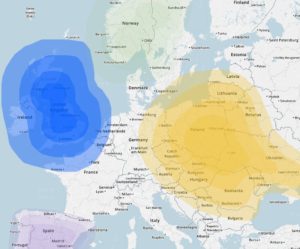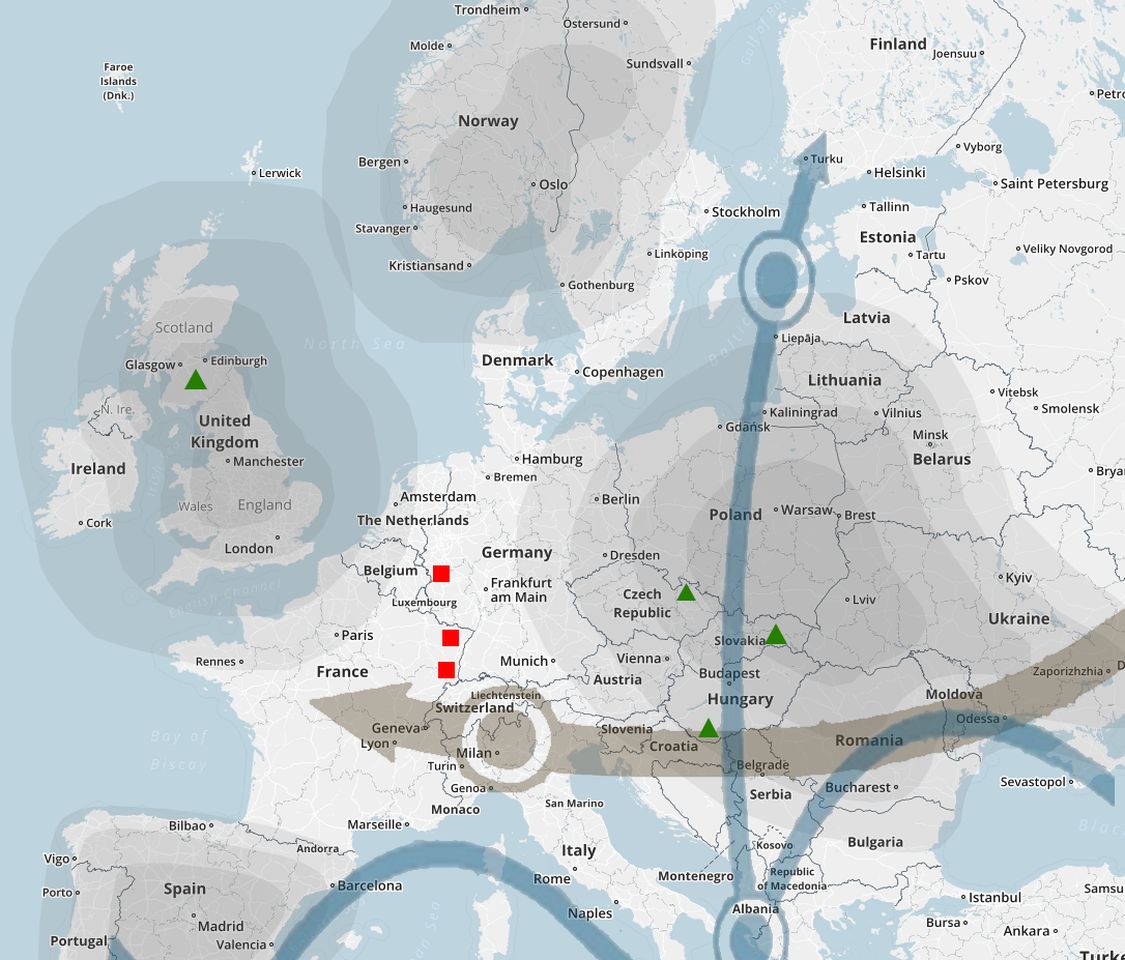 My autosomal DNA test results indicate I’m 98% European, which is further broken down to 49% British Isles, 36% East Europe, 9% Iberia and 4% Scandinavia. The remaining trace 2% is either Southeast Europe or simply “noise,” which is unexplained variations in the data.
My autosomal DNA test results indicate I’m 98% European, which is further broken down to 49% British Isles, 36% East Europe, 9% Iberia and 4% Scandinavia. The remaining trace 2% is either Southeast Europe or simply “noise,” which is unexplained variations in the data.
Ethnicity predictions depend on many factors and are only approximate. They represent similarities of my DNA, my past really, with representative samples from modern populations. The ethnicity map does agree strikingly with my mother’s lineage. Her father’s side was likely from Scotland and her mother’s side is proven to be from Hungary and Slovakia. However, I inherited roughly 50% of my autosomal DNA from my father. That means my father’s side is also some combination of this very same ethnic mix, with a little Spanish (9%) and Scandinavian (4%) thrown in somewhere.
Ethnicity Map
What does this mean in a practical sense? To find out, I superimposed three additional maps over my ethnicity map. My ethnicity is represented by two large gray shaded regions, one over the United Kingdom and one over Hungary, Poland and the Ukraine. To a lesser extent there are also shaded regions over Spain, and over Norway and Sweden.

Haplogroup Migration Paths
Next I superimposed my paternal ancestor’s migration route. My estimated Y-Chromosome DNA haplogroup is R-M269, also known as R1b. Their ancient migration path is the dark arrow that sweeps from east to west across Romania and into France. I also superimposed my maternal ancestor’s migration route. My mitochondrial DNA haplogroup is H1g1. One branch of that haplogroup moved north through Hungary and into Finland.
So far, my Eastern European ethnicity coincides with my maternal haplogroup and my British Isles ethnicity coincides with my paternal haplogroup, if we extend the migration westward into the United Kingdom.
Known Locations
Next I superimposed the known locations where my maternal ancestors (green triangles) and paternal ancestors (red squares) were born during the eighteenth and nineteenth centuries. Locations for my maternal ancestors coincide with both my maternal haplogroup and my Eastern European ethnicity. Likewise, locations for my paternal ancestors coincide with my paternal haplogroup, but do they coincide with my “British Isles” ethnicity? The red squares appear outside of my ethnicity estimates (shaded regions).
False Ethnicity
I think the key to interpreting ethnicity is the comparison to modern populations. After my paternal ancestors settled in southwest Germany and northeast France, others in the same haplogroup continued their westward migration through hundreds or thousands of years. Today, their descendants happen to be concentrated in the British Isles.
With respect to my paternal ancestors, my ethnicity is probably not “British Isles,” but I do share DNA with those who eventually settled there. Does that make my ethnicity “British Isles?” I think not in that sense for my paternal line. Note there is still a chance my great-grandfather Voisin’s mother was from the British Isles, so I may find I actually have that ethnicity paternally.
With respect to my maternal ancestors, my maternal haplogroup continued their migration northward into Scandinavia. Another branch continued their migration westward into Spain. This could explain my Scandinavian (4%) and Spanish (9%) ethnicity. I am probably not actually Scandinavian or Spanish, but I share DNA with those who eventually settled there.
Conclusion
Perhaps I interpreted my ethnicity map to fit what my genealogical paper trail shows: I am mostly German and Eastern European, with a little Scots-Irish thrown in. It would be difficult to do the reverse: Use an ethnicity map to determine who your ancestors were. The comparison to modern populations doesn’t seem to give an accurate picture of the past.
Ancient haplogroup migration paths in combination with ethnicity maps provides a better picture. Still, haplogroups correspond to a very narrow group of ancestors, that being my father’s father’s father, and my mother’s mother’s mother, and so on. My true ethnic mix will include hundreds of other ancestors that are not included in just those two haplogroups.
Note that a whole branch of my maternal ancestors is from Scotland and Ireland. So even though my paternal ancestors may not have originated in the British Isles, many of my maternal ancestors did. They necessarily contribute to my British Isles ethnicity. In effect I am part actual British Isles ethnicity mixed with a part that is inferred by extending the R-M269 haplogroup migration path into the British Isles.
Ethnicity estimates do not seem to account for time. That is, the place where our ancestors flourished along their ancient migration path seems to have no bearing on DNA comparisons to modern populations. On the other hand, a genealogical paper trail represents relatively recent time periods, especially when compared to ancient migration paths. The connection between ancestry and ethnicity is not straight forward.
Disclaimer: I am not an expert in genetic genealogy, so what I say may not be accurate. I am simply trying to make sense of my ethnicity estimate using what I already know of my ancestry.

Especially south and west germans often recieve brittish results. I’m a Danube-Swabian Hungarian and my german ancestors came from Bavaria, Baden-Württemberg and in lower numbers from the west of the country and even Luxembourg and France. I have done extensive research on my family’s ethnicity and I’ve got to notice that my south german roots were often confused woth brittish results. I know for sure I have no brittish ancestors because I’m not American, I live in Hungary and I don’t know of any Brittish ancestors that could’ve given me such amount of the mentioned ancestry. But just with some historical knowledge and pure logic I came to the conclusion that Brittish genetic subclade just refers to a celto-germanic mix. And that is exactly what south germans are. The Gauls have settled that region (in Bavaria the Boii) and even through genetic tests it’s visible that south germans have a lot less germanic ancestry than northern germans and scandinavians. I have also recieved 11% irish, scottish results and there really is no possibility for the scenario that I have one irish great-grandparent because I have records of all of them.
Sorry if my english has any improfficiencies.
I hope I could help!
Thanks for writing. As the DNA testing companies continue to update their estimates, my ethnicity has converged towards my known ancestry. They are probably drawing from a larger population of test takers and thus the results are getting more accurate. But I have since discovered my full ancestry and my ethnicity estimates are still incorrect, percentage-wise. Add to this the randomness of DNA inheritance. My brothers have very different ethnicity percentages from me. It is obvious ethnicity estimates cannot answer questions of ancestry, but only provide clues. The estimates are necessary information, but not sufficient in themselves.
I’m glad to hear of your experience. We are two examples that prove ethnicity estimates are not sufficiently accurate to help in researching one’s ancestry. I think people expect their ethnicity estimates to define the places from which they came. In reality, comparing ourselves to modern populations doesn’t correlate with the times and places along the ancient “migration” routes of our ancestors.